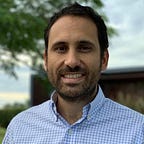A simple yet powerful question
Drawings are back after a little bit of a summer vacation! And it is time to leverage the great conversation with Andrea Serrano for the next series of them.
When we discussed about “the choice” with Andrea she mentioned a key question in a key time in her life. A very simple one but still so powerful. As Andrea was leaving a big corporation she has worked for for many years, she starting asking herself: “What do I really want to do?” And this is not the first time I hear this question and probably, very probably it is not the last one either.
The reason we keep coming to this question when we are going through change and key decisions is because it can help us unlock our full potential. If we take the time to think about it, if we go really deep, the answer can uncover a much brighter future.
I decided to draw this combination of heart and brain or mind because I feel it is a good representation of how tough of a question this one could be and how difficult but also rewarding finding the right answer could be. Andrea talked about the implications and questions around a key decision about our careers. What would others say? Is my spouse aligned? Is this what I wanted for my career? Will this make me happy? Will I be able to continue to provide for my family? Am I passionate about it? Am I contributing? Am I learning? Does this add value for others? Does it have a purpose? I hope you can see through this questions why I chose the heart and the brain. It is tough to make those decisions with just one, it will probably be both and depending on the case it can be one more than the other.
As I was writing this story, I automatically remembered some interesting pieces from “Think Again”, the latest book from Adam Grant. The book has a lot to offer when it comes to thinking and re-thinking our careers and what do we really want to do. The following bullets are a summary of what I found more inspiring in the book:
- We should allow ourselves to change tracks when we need to
- We shouldn’t settle down prematurely on a sense of self without enough due diligence and close our minds to alternative selves. This is known as “Identity foreclosure”
- It all starts when people ask young kids “What do you want to be when you grow up?” That question fosters a fix mindset between work and self. Work is what you do, not who you are. Be open to exploring different possibilities
- Your future self doesn’t exist. Your interests may change. Identity foreclosure can stop us from evolving.
- When it comes to our careers, it is better to lose the past 2 years of progress than to waste the next 20.
- There is a helpful framework for those who feel have reached a learning plateau in the workplace and want to pivot. As people consider career choices and transitions, it helps to think like scientists:
- Entertain possible selves: Identify people you admire within or outside your field and observe what they actually do at work day by day.
2. Develop hypotheses about how these paths might align with your own interests, skills and values.
3. Test out the different identities by running experiments: do informational interviews, job shadowing, and sample projects to get a taste of your repertoire of possible selves — which keeps you open to re-thinking.
- At work and in life, the best we can do is plan what we want to learn and contribute over the next year or two and stay open to what might come next. To adapt an analogy from E. L. Doctorow, writing out a plan for your life “is like driving at night in the fog. You can only see as far as your headlights, but you can make the whole trip that way”.
- We don’t have to upend our entire paths to rethink some of our plans. Some people are perfectly content with their fields of work but dissatisfied with current roles. Others may be too risk averse to make a geographic move for a job or a partner. And many don’t have the luxury of making a pivot: being economically dependent on a job or emotionally attached to an extended family can limit the options available. Whether or not we have the opportunity or appetite for major changes in our lives, it is still possible to make smaller adjustments that breathe new meaning into our days.
- It takes humility to reconsider past commitments, doubt to question our present decisions, and curiosity to reimagine future plans. What we discover along the way can free us from the shackles of our familiar surroundings and our former selves. Rethinking liberates us to do more than update our knowledge and opinions — it is a tool for leading a more fulfilling life.
Asking ourselves what do we truly want to do and using some of the advice from Adam Grant can help us become better employees: Think like a scientist daily and be open to more and better opportunities for your careers as you grow and develop.
